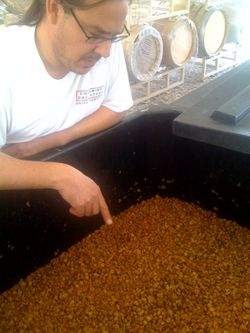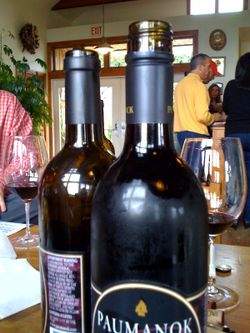Long Island Wine Country Trip Report: At Channing Daughters and Paumanok, Experiments Yield Success
By Evan Dawson, Finger Lakes Editor
Morgan and I took our first trip to Long Island wine country last weekend and I plan to share some observations and experiences in a series of upcoming posts. They are in no particular order of quality or chronology, and I should state emphatically that the winemakers and owners we met were excessively generous with their time and cellars.
Long Island wine country is, in no small measure, a must-visit for New York wine enthusiasts. It is wildly different when compared to the state's other appellations. The vineyards are flatter than a cookie sheet and gorgeously maintained, and there are unique stories and approaches to find in each stop.
Paumanok Vineyards is situated on the North Fork and Channing Daughters Winery lies in the Hamptons, but there is a common theme to be discovered at each — experimentation is yielding some fascinating results.
We tasted 22 wines at Channing Daughters, where winemaker Chris Tracy seems to take particular delight in unveiling the menagerie of bottlings.
Do you like chardonnay? They have, in some form or another, six of them. There are three roses. You can find pinot grigio, and you can also find a richer, copper-colored version with the body of a supermodel. But for me, the most interesting and enjoyable experiment comes with Tocai Friulano, which shows up in a handful of Tracy's bottlings.
Tocai is an experiment that only Channing has seen fit to make on the island. "We don't view our land as only suitable for merlot, or only suitable for sauvignon blanc," Tracy says, smiling. "We have similarities to a range of wine regions like Friuli, but of course we're ultimately our own place. And we've found that tocai can make some wonderful, fresh wines here."
Fresh is the word. These wines, designed to drink young, are aromatically dynamite. Tracy uses tocai to add characteristics that are unique on Long Island. A cynical customer might think there are a variety of blends because it allows Channing to sell more wine. To some degree that must be true — a wine geek would positively salivate at the idea of buying a horizontal of varyingly styled chardonnays or pinot prigios. But any cynicism should fade when the customer hears Tracy explain the reason for each blend. Tracy is intensely thoughtful, and tasting with him is a hell of a lot of fun.
I didn't love each wine, but I appreciated his reasoning. 
Up at Paumanok, winemaker Karim Massoud is making one of my favorite red wines in New York state: a straight petit verdot. He's only made it twice, in 2005 and 2007, and he only plans to make it in standout vintages. The variety is otherwise a nice blending grape, but I thought it was distinctive on its own.
"Petit verdot has smaller berries, so it naturally provides more tannin, color and acid," Massoud told us over lunch in the tasting room. "We're excited to see what it does on its own, but it's still difficult to judge. Even the 2005 is a young wine."
He's right. The 2007 still strips some enamel and the '05 is big and rough with tannins. My bottle will have a long time to mellow before I open it. Even now, though, it's clear that the Paumanok petit verdot will offer a unique profile when compared to the merlots and cabernet francs that dominate the region.
They're even experimenting with closures at Paumanok.
You can see in the picture that the '07 Merlots are divided between natural cork and screw cap. Massoud suspects the screw capped wines will age gracefully, but at some point they'll have a perfect opportunity to test the closures side by side.
I'm thrilled with the idea of exploring new varieties in this state.
Certainly we're seeing that cabernet franc can shine across New York wine regions, and I'd even argue that in the small sample size of what is produced, blaufrankisch has a bright future. But each piece of land offers different possibilities.
The Finger Lakes growers are wise to experiment with varieties like gruner veltliner and zweigelt, while Long Island growers are making strides with petit verdot and even tocai in the Hamptons. Merlot and riesling will always be there. Now we're finding out what else will join the viticultural party.















At TasteCamp, I found Paumanok and Channing Daughters to be some of the most innovative operations we visited, enologically and viticulturally (respectively). I want to be around when there is a blind test done to see which closure does better on which varieties. My guess is that a triangle test (2 of one treatment, 1 of another) would elucidate a sensory difference between the closures. I would love to know what a blind test would show preference-wise, and how that result would change over time.
There hasn’t been too much sensory data about aging with screwcap vs. cork closures. It’s an exciting time to be a closure enthusiast!
Finally, this is what im talking about. It makes me want to puke when someone tells me they are planting Chardonnay or Merlot (BARF). No dissing it (well actually I am dissing chard, boring stuff), or Merlot or Cab, but it like so mayo and whitebread, its completely unadventurous from a growing perspective. Ive said it before, but I dont know how NY expects to stand out making Merlot or Cab Franc. Even if we do it well, so does just about everybody else. Even Pinot is getting so overplanted its begining to mean nothing. It’s a shame that grape farmers are the only farmers in the world who refuse to see the merit of hybrid varieties … Long live the JonaMac.
Rowland -
Let me play both sides. First, it’s easy to understand why Long Island plants a lot of merlot and the Finger Lakes plants a lot of cab franc. I don’t understand pinot noir — unless the grower is uber-committed. But there’s nothing wrong with highlighting a strength.
Like you, though, I dig the exploration. I think there’s a real future for NY blaufrankisch. What else would you like to see — or have you seen — that excites you?
as someone who is in the process of selecting varieties to plant, I understand why people plant what they do, because its a scary process, once you make a decision you have to stick with it for decades, its your entire future. people plant merlot and cab because it grows well, there is a market for it, and investors and customers are familiar with it. I have been seriously considering planting both Tocai and Petit Verdot, and here in the Hudson Valley, basically everything is an experiment. I would like to see how Stoutridge’s wines come out over the next few years; their vineyards of Teroldego, Sangiovese, and Refosco should be bearing fully this year. Millbrook has been sucessfully growing and making Tocai for a while now. Glorie and Pazdar both grow Lemberger (people up here seem to have decided Blaufrankish is too hi brow a name) but im not sure if they make single varietals or blend it. Ive enjoyed Millbrook and Oak Summit’s Pinot Noirs, but I cant say how great they are compaired to anything else. I guess Id like to see more Norther Italian, Austrian, and Eastern European varieties planted. Id like to see Cornell take a more active role, instead of having their experimental vineyards dedicated to making new crosses, they should be trying every single varietal they can get their hands on. Id like to see every grower dedicate an acre to single row varietal experimentation.
Great to see that Chris keeps experimenting!
Oddly enough Ive been reading about about the CIA and Afganistan, and the author makes dozens of passing references to vineyards and winemaking. Any idea what kind of grape variety they are growing in that part of the world? Id like to try it whatever it is.
Wild guess: Sereksiya and Saperavi, or any other Georgian grapes. This is based on nothing but a guess that any grapes there might have come from Soviets.